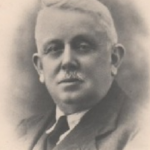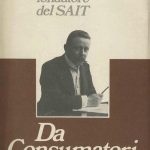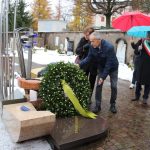He was born in 1872 in Romeo (Val di Non) from a wealthy family.
After attending the university of industrial engineering of Graz in Vienna, he was called back to Romero, his native village, by don Francesco Giuliani, for contributing to the creation of a local cooperative, a social cooperative store.
In 1896 during a conference he claimed that cooperation is “the strength resulting from the combination of several individuals who, helping each other, seek their own well-being and the common well-being. The bond that links the various members is solidarity and the reciprocal rights and duties”.
The cooperative associations moreover represented for Lanzerotti “the safest remedy to the social issue”, totally agreeing with the position of several economists of that time (among which the great John Stuart Mill) who were happy to see that the conflict of capital and work was diminishing thanks to the establishment of cooperatives.
Within the cooperative field he was among the founders of the first “Cassa Rurale Cattolica” (the first one exclusively confessional in Trentino), of SAIT (of which he was the first president) and of the hydroelectric power plant construction Society on the Novella stream and he rose to become the role of vice president of the Federation of cooperative Consortia.
Lanzerotti was persuaded that the cooperation didn’t have to be solely involved with the field of consumption, but also with that of production. In 1904 he wrote in fact that “SAIT will develop its wide and entire activity, not just thinking of its members as consumers, but also engaging them as workers and producers in industrial cooperatives”.
Being convinced of the necessity of a strong financial aid, he will support the project to create an industrial Bank, aimed at ”encouraging the establishment of industrial, agricultural, sericultural, vine societies and similar; the electrotechnical, transport and hotel societies”. The purpose is clear: “ensuring that a consumer is also a producer. In this way the money doesn’t fall outside but stays among us, it circulates in the country, it brings you life and economic revival”.
During the first year of ‘900 he founded, together with don Celestino Endrici and Edoardo De Carli, the Catholic University Association of Trentino, that will publish one of his magazines, “Rivista Tridentina” with Alcide Degasperi as director, in 1902.
He was politically active too, participating in the foundation of the catholic democratic party. In 1906 he was elected deputy at the Assembly of Innsbruck and the following year, together with don Giovanni Panizza, Reichstag deputy in Vienna in the Austrian-Hungarian period.
His adhesion to irredentist positions brought him hostility within the local catholic world, but above all by the Austrian government that, at the outbreak of WWI, after his escape to Italy, sentenced him to death in absentia for irredentism and high treason (without the sentence ever been carried out).
In the consultations held on 13th June 1911 the catholic party decided not to propose him again together with other representatives of the cooperative world. It was Alcide De Gasperi who communicated the decision to Lanzerotti, with a letter where he invited him to think of "your own economic independence from the party“
When the war was over, he came back to Trentino, where he found an unfavourable atmosphere to him that made him move to Milan, where he opened a design studio specialised in planning railways and power lines.
In 1936 he moved to Masnago (Varese) at his daughter’s, the last remaining child he had, after a difficult period of mourning and controversy.
In 1999, the centenary of SAIT foundation, his remains were brought from Varese to the cemetery of Romero.
SAIT President Roberto Simoni on the grave of Lanzerotti, on the occasion of the consortium’s 120 years of foundation.
Among his numerous writings:
• Cooperazione. Contributo allo sviluppo della cooperazione, 1898
• Programma delle ferrovie elettriche a scartamento d'un metro nelle Alpi orientali elvetiche, trentine, dolomitiche, 1910
• Le officine elettrico-industriali dell’Alta Anaunia e la centrale elettrica sul Novella, Trento: Tipografia Art. Trid. di G. Moncher, 1913
• Un po' di storia della ferrovia dell'Alta Anaunia: Dermulo-Fondo-Mendola: episodi di lotte economiche e nazionali sui confini della nazione, 1919, pp.40
• Pagine di propaganda per le cooperative di consumo, 1919
• Nel mondo elettrico, 1932
• Le riforme germaniche sulla revisione aziendale delle cooperative, Estratto dalla rivista internazionale di scienze sociali. Anno XLIII, Fascicolo II, marzo 1935, Milano: Società Editrice “Vita e Pensiero
• Pro Memoria a difesa delle iniziative delle opere ed istituzioni elettriche trentine, 1942, pp.72
• Promemoria di un vecchio cooperativista trentino sulla vecchia sistemazione delle attività cooperative italiane, 1944, pp.16
• Ricordando Giuseppe Toniolo, animatore ed ammiratore dell’azione sociale cristiana cooperativa, III Edizione, Varese: Taverna Libreria Editrice
• Scritti scelti, Associazione culturale G.B. Lampi, 2010, pp.213
• Caratteri intrinseci della cooperazione, 1907
“Le cooperative di consumo da noi promosse si devono considerare come aziende utili immediatamente per i piccoli vantaggi che recano ai soci (minor prezzo, migliore qualità, peso esatto e facilità di acquisto e di controllo della merce) ma più ancora come il nucleo primitivo dell’apparato sociale futuro, più o meno perfetto, destinato in un, speriamo prossimo avvenire, a regolare la distribuzione e il consumo delle ricchezze e dei beni e poi in un tempo posteriore a regolarne la produzione e lo scambio.
La strada della cosiddetta ‘libera concorrenza’ fa sudare sette camice agli economisti moderni, specie quando per “libertà” s’intende “licenza”, quando il piccolo, il povero, il debole è allo sbaraglio, quando manca la carità e la fede.
Le cooperative di consumo son sempre state per me la base della cooperazione produttiva e di tutta la cooperazione. Già fin dalla fondazione della mia prima cooperativa di consumo, il problema difficile di procurare alle cooperative di consumo i mezzi finanziari necessari per lo sviluppo della loro attività economica mi portò subito ad apprezzare ed a studiare anche tale lato del loro funzionamento.
Quando il danaro è in mano del socio cooperatore è danaro “personale” sul quale il sentimento, il dovere, lo spirito di sacrificio, può agire, quando il socio lo porta alle istituzioni di credito, il danaro si allontana dall’uomo, si materializza perde la sua prepotenza che può essere perfino e spesso contro che lo ha faticosamente risparmiato, raccolto, affidato a predetti amministratori, banchieri, capitalisti, gerenti gli istituti di credito.
Il fenomeno economico cooperativo è estensivo e non intensivo direi quasi, è qualitativo e non quantitativo. Si tratta piuttosto di raccogliere molte piccole unità economiche e non di speculare su poche e grandi operazioni finanziarie.
La vita cooperativistica, come quella nostra spirituale, è formata da un complesso di dolcezze, di consolazioni, di entusiasmi ma anche di delusioni, di desolazioni, di aridità.
La nostra forza, la nostra virtù sta nel vedere e nell’accettare dalla Provvidenza le prime con buono spirito di umiltà, e nel sostenere le seconde con coraggio, preparandoci con serenità e con tutta confidenza al superamento delle crisi morali o materiali che ci seguono o ci precedono o ci accompagnano.
Coloro che giudicano la cooperazione il toccasana, o la vogliono troppo perfetta senza difetti o debolezze umane e la stimano soltanto in quanto porta un mediato utile materiale, coltivandola senza una preparazione morale cristiana, non sono veri cooperatori.
La tesi fondamentale cooperativistica, che è in contrasto col naturale istinto del tornaconto individuale, il vero principio della cooperazione cristiana è sempre stato da me esposto graficamente e parabolicamente come: Date, Date, Date, come la goccia dà all’albero e questo alla terra, al rivo, al terreno, al fiume, al mare, al cielo, alle nuvole, che formano poi di nuovo la goccia."
Further readings:
• Enrico Quaresima, Emanuele Lanzerotti: necrologio, in Rivista Studi trentini di scienze storiche, 1956, A . 35 (1), pp. 107-109
• Luciano Imperadori, Da consumatori a produttori: vita e opera dell’ing. E. Lanzerotti fondatore del SAIT, 1979.
• Fabio Giacomoni, Renzo Tommasi, 100 anni di SAIT. Una storia del Trentino. Le radici della cooperazione di consumo trentina: 100 personaggi per 100 anni SAIT, 1999.
• Andrea Graiff, Memorie e cronache di Romeno, Francisci Editore, 2001, pag 245 – 48.
• Mariagrazia Sironi, Emanuele L. Il fascino dell’essere insieme. Note biografiche di Renzo Tommasi, Edizioni Lativa, 2011.




